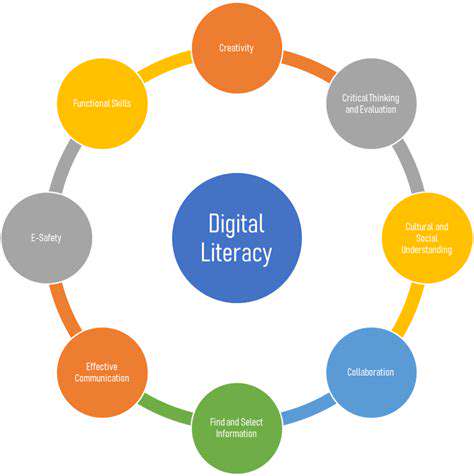Data Governance and Ethics in EdTech: A Roadmap
Protecting student data is paramount in today's digital age. Schools and educational institutions have a crucial responsibility to safeguard sensitive information about students, ensuring compliance with relevant privacy regulations and fostering a secure learning environment. This involves implementing robust security measures and maintaining a culture of data privacy awareness throughout the entire school community.
The increasing reliance on technology in education necessitates a proactive approach to data protection. From student records to online learning platforms, safeguarding this information is not just a legal obligation; it's an ethical imperative.
Data Minimization and Purpose Limitation
Schools must collect only the minimum necessary data required for legitimate educational purposes. Excessive data collection can lead to unnecessary risks and potential breaches. Clearly defining the specific purposes for data collection is crucial. For instance, collecting a student's address for mailing purposes and not for marketing campaigns is an example of a data minimization approach.
Furthermore, limit data collection to only what is absolutely necessary. This minimizes the potential for misuse and unauthorized access.
Access Control and Security Measures
Implementing strict access controls is essential to prevent unauthorized access to student data. Strong passwords, multi-factor authentication, and regular security audits are vital components of a robust security framework. Regular security training for staff is also paramount to maintain awareness about potential threats and best practices for data protection.
Employing encryption technologies for sensitive data both in transit and at rest is another critical step. This safeguards student information even if a system is compromised.
Transparency and Communication
Schools must maintain transparency with parents and students regarding data collection practices. Clear and concise policies outlining how data is collected, used, and protected are vital. Providing readily accessible information about privacy rights and procedures is essential for building trust and fostering a sense of security.
Regular communication regarding data security updates and incidents is also critical to maintaining trust and ensuring prompt responses to any breaches.
Compliance with Privacy Regulations
Adhering to relevant privacy regulations, such as FERPA (Family Educational Rights and Privacy Act) in the United States, is paramount. Understanding and implementing these regulations is crucial to avoid penalties and maintain legal compliance. This involves staying informed about updates and revisions to these regulations and ensuring policies align with the latest guidelines.
Seeking professional guidance from legal experts specializing in education law is a wise investment to ensure full compliance and avoid potential legal issues.
Staff Training and Awareness
Comprehensive training for all staff members is essential to foster a culture of data privacy awareness. Regular training sessions should cover best practices for handling student data, including password management, secure data storage, and reporting procedures for potential breaches.
This proactive approach ensures that everyone involved in the educational process understands their role in safeguarding student data. It strengthens the overall security posture of the institution.
Promoting Transparency and Accountability

Promoting Open Communication
Transparency in communication is crucial for fostering trust and accountability within any organization. Open communication channels allow stakeholders to access information readily and understand the decision-making processes. This includes providing regular updates on progress, challenges, and any deviations from the initial plan. This proactive approach not only builds trust but also allows for early identification and mitigation of potential issues.
Encouraging open dialogue through forums, surveys, and feedback mechanisms allows for a two-way exchange of information. This feedback loop is essential for understanding diverse perspectives and ensuring that decisions reflect the needs and concerns of all involved parties. Active listening and thoughtful responses to feedback demonstrate a commitment to transparency and accountability.
Establishing Clear Reporting Mechanisms
Implementing clear and consistent reporting mechanisms is vital for maintaining transparency. This involves defining specific metrics, timelines, and reporting formats that are easily accessible and understandable by all stakeholders. The reports should accurately reflect the performance, progress, and any challenges encountered.
Regular reporting facilitates continuous monitoring and evaluation of activities. This allows for adjustments to be made promptly when necessary, ensuring that efforts remain aligned with objectives. Detailed and timely reports are essential for demonstrating accountability and building trust amongst stakeholders.
Ensuring Data Accuracy and Integrity
Accurate and reliable data is the cornerstone of any transparent process. Data integrity is paramount to ensuring the validity of reports and analyses. Robust data management systems and procedures are essential to protect data from errors, tampering, or unauthorized access. This includes implementing appropriate security measures and adhering to data privacy regulations.
Regular audits and checks of data accuracy are crucial to maintain trust. The ability to confidently rely on data is vital for making informed decisions and promoting transparency throughout the organization. This underscores the importance of a culture that values data integrity and accuracy.
Providing Accessible Information
Making information readily accessible to all stakeholders is a key element of transparency. This means employing various methods, such as easily understandable documentation, user-friendly websites, and clear presentations. Clear and concise communication is essential for ensuring that everyone can grasp the information presented.
Providing multiple channels for accessing information, such as online portals, printed materials, and presentations, caters to diverse learning styles and preferences. Ensuring that information is readily available to everyone, regardless of their background or location, reinforces the commitment to transparency and inclusivity.
Accountability Mechanisms and Processes
Establishing clear accountability mechanisms and processes is critical for effective transparency. This includes identifying individuals or teams responsible for specific tasks and outcomes. Defining clear responsibilities and deadlines ensures that everyone understands their role in achieving goals and maintaining accountability. This process is crucial for maintaining trust.
Implementing systems for tracking progress, evaluating performance, and addressing any deviations from the plan is essential for ensuring accountability and promoting transparency. Regular review and evaluation of these mechanisms are necessary to ensure their effectiveness and adaptability to changing circumstances. This ongoing process reinforces the commitment to accountability and transparency.











